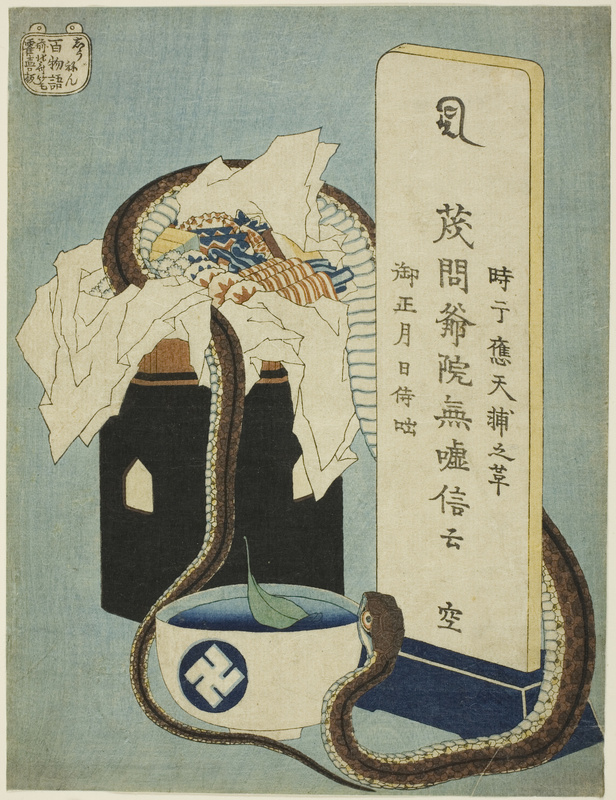Images of the Floating World
What is Ukiyo-e?
The start of the Ukiyo-e art style coincided with the beginning of the Edo Period of Japan (1615-1868 CE). This era is typically considered a time of peace, political stability, and economic growth, which is often attributed to the conservative Tokugawa shogunate that was in power during this time. The word Ukiyo was oroginally a Buddhist term which meant ‘to float,’ and was supposed to represent the impermanent nature of life. But during the Edo period, this pessimistic idea was overturned, and the term Ukiyo-e was born, meaning “pictures of a floating world,” expressing an attitude of joy for life. Thus, Ukiyo-e artists generally depicted the idea of Japan’s pleasure districts, which began to spring up around major Japanese cities like Edo and Kyoto.
The term ‘pleasure districts’ was meant to refer to urban centers that arose during this period in which entertainment for the masses could be found. A majority of Japan’s citizens could enjoy these little pleasures because of the flourishing economy and a growing middle class. They could worry less money about their work and homes and were able to cultivate a life outside of their work and homes, a luxury initially only afforded to the elites and aristocracies. These areas became popular for Ukiyo-e artists because their art could be produced on a large scale and cheaply, and there were plenty of people around to purchase prints or books of prints. Popular subjects from the pleasure districts included courtesans and Kabuki actors, along with other subjects like landscapes and Japanese folklore.
Ukiyo-e prints are done through a technique called woodblock printing.This was a revolutionary technique during the Edo period that allowed artists to create multiple prints of the same art piece, so they could be sold cheaply and to many people at once. Woodblock printing was a multi-person process, involving a commissioner, an artist that would carve the image into a woodblock, a printer to transfer the image onto a sheet of paper with ink, and a publisher to publish, and often sell, the books of prints.
Want to see the process in action? Watch this fascinating video from the YouTube channel “Christie’s”:
After Japan opened themselves up to world trade in 1853, the Western world began to see the influence of Japanese art in their own art and design. This influence on European art is referred to as Japonisme, and it can be seen most clearly in the compositional and stylistic choices made in Impressionist and Post-Impressionist artwork. Some of the most well known artists today that have been influenced by Japonisme are Edgar Degas (1834-1917), Vincent Van Gogh (1853-1890), and Claude Monet (1840-1926).
While Ukiyo-e artists used many different subjects and genres to express this notion of “the floating world,” this exhibit will take a close look at the depiction of folklore, myth, and legend in Ukiyo-e prints. The print “Young Woman Riding a Phoenix” by Suzuki Harunobu (1725-1770), for example, is just one of many different depictions of a deity. While scholars are unsure who the woman in the print is supposed to be, it has been interpreted as a Chinese immortal sage.
Many Ukiyo-e artists created prints across the spectrum of genres that Ukiyo-e artists used. Katsushika Hokusai (1760-1849), for example, is best known today for his work in landscape paintings. However, he was also known during his time as “the painter of phantoms,” because of his love for the macabre and his propensity for drawing terrifying creatures. In his series “One Hundred Ghost Tales,” Hokusai creates haunting images of popular Japanese ghost tales and legends. “Memorial Anniversary” from this series shows a snake crawling over a display of items used in a memorial service for the dead. In this case, the snake is representative of malevolence or anger, a common representation of snakes in Buddhist culture.
Other artists, like Hiroshige Utagawa (1797-1858), stuck to a single genre and made their fame off of the subject they most often depicted. Hiroshige is also well known for his landscape art. However, unlike Hokusai, he specialized in depicting different views from around Japan, appealing to tourists and people going on pilgrimages in his different series, like “One Hundred Famous Views of Edo” and “The Sixty Nine Stations.”
Most Ukiyo-e artists trained in specific art schools that helped them develop their talents. Like Hiroshige, Utagawa Kuniyoshi (1798-1861) studied in the Utagawa school. Kuniyoshi became known as one of the greatest masters of Ukiyo-e woodblock art. Similarly to Hokusai, he dabbled in several different genres of print including landscape, Kabuki actors, and myth. He is most well known today for his triptych “Takiyasha the Witch and the Skeleton Spectre,” a haunting depiction of a famous Japanese ghost story.

